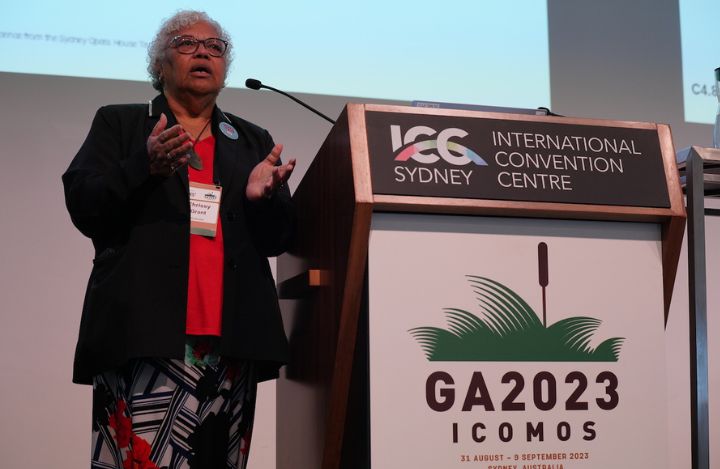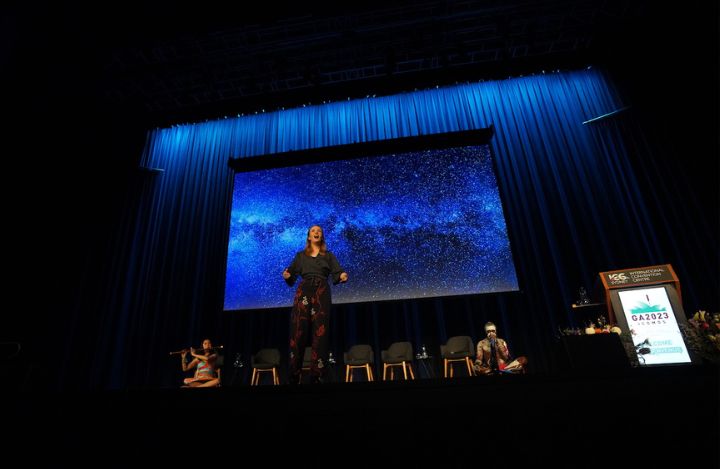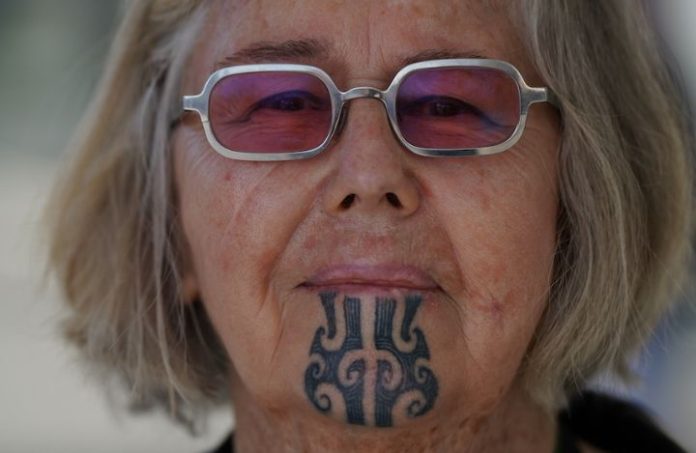Imagine a group of over 1,400 people assembled in Sydney from as far away as Estonia, Norway, Canada, but together to meet old friends, make new ones and talk about heritage rights, responsibilities, resilience and relationships. The main relationships formed were with those from Australia and Pasifika including leaders, government representatives and those there to tell their stories.
The International Council on Monuments and Sites (ICOMOS) General Assembly, the event which brought people together, had been over six years in the planning as Covid 19 prevented the event previously planned for 2020. Those taking part brought stories of their heritage which included land protection, as well as their expertise as architects, planners, and many other areas of knowledge on heritage management.
For the first time, the General Assembly was launched by a Welcome to Country from Gadigal especially for Indigenous, in the Royal Botanic Gardens, overlooking the Bara sculpture and Opera House below. This started an emotional journey for those present.
The Murujuga people from Western Australia shared stories about their lands and rock carvings which were over 50,000 years old at a Cultural Landscape Symposium. All there learnt of others’ world heritage experiences, and the opportunities and threats to Murujuga people of a World Heritage inscription. Invited speakers had mixed experiences, some dark. Those from Budj Bim proudly showed their Country with their deep history of eel farming practice, which is now a World Heritage site, as an example of an Indigenous-led and successful World Heritage inscription.

Maina Talia from Tuvalu showed a video and eloquently explained the impacts of climate change on their islands, youth and future. He discussed waves washing over his community’s island, salt pollution of land and aquifer, and those who moved to other places treated as climate “refugees”, a demeaning description. He was also part of a panel on Caring for Country where he and Sarah Forgesson of Ngāti Whākaue, New Zealand advised that action is needed immediately, as the worlds’ and our responsibility. Threats are increasingly evident to our coastline communities, wildlife and places of belonging for thousands of years. Bushfires, droughts and species as well as lives lost in Australia, are part of climate change impacts. Better ways of managing lands were topics which brought people together.

Nine themes and four programs in the three-day Scientific Symposium provided a platform for discussion on the links between nature and culture, Indigenous heritage the other topics. The overall theme of the symposium was Heritage Changes, on rights, responsibilities, resilience and relationships. All presentations, round-tables, events, site visits, meetings and discussions contributed to the making of relationships which will continue to show that we are not alone as heritage changes, and we can find better ways to maintain connections to our places and Country. Sydney showcased key heritage streets and buildings including at a Youth Forum and a welcome in the Opera House.
The Pacific Diaspora event, Welcome to Country, bus visits to Blue Mountains locations, and the Murujuga Cultural Landscape Symposium, were included in the Indigenous Heritage Symposium. The focus of this program though was two days of papers from 67 speakers on best practice, human rights, reform, partnerships, traditional learning, customs, management systems, protected areas, and sustainable futures. The program was crammed to include all speakers with teams of Aboriginal peoples from throughout Australia. Two important presentations were from an Indian tribal group on living bridges and their tribal home, philosophy and customs, and from the survivor of an Aboriginal boys’ home where those incarcerated were only given numbers, as in a prison but with young children.
Aiming to achieve more than colleagues and memories, and to use the gathering as a lever for greater integration of Indigenous heritage values in the activities, thinking and knowledge of ICOMOS, three sets of resolutions were prepared. The resolutions were collaboratively discussed in online meetings over several months, before submitting to ICOMOS at the end of July, for dissemination to its 10,500 members from some 150 countries. The three sets of resolutions covered Indigenous values and World Heritage; Indigenous heritage and climate change; and Indigenous heritage inclusion in ICOMOS. The resolutions were outlined at the first plenary session, voted on by all international voting members online, and all the resolutions were strongly supported. The resolutions were agreed by a networking meeting of 20 after the conference to be interrelated and that we should put effort into working on them all.
Those at the networking meeting who attended the events over the period from August 30 to September 10 remained exhilarated, keen for Indigenous relationships made to continue and to build and share their knowledge, and it will do so. My lasting memory is of the dance group from the Cook Islands, who entertained the Pasifika Diaspora event, held in the main hall of the Australian Museum. I could almost feel the DNA links in my body, back to tuakana in the Pasifik, and know we are all in this together, our heritage links to Moananui a Kiwa are strong and we must all take care with our waters.
_______________
Dr Diane Menzies, a Rongowhakaata, Aitanga a Mahaki woman from Aotearoa New Zealand, co-chaired the Indigenous Heritage Program at the ICOMOS 21st General Assembly and Scientific Symposium with Dr Lyndon Ormond-Parker – an Aboriginal man of Alyawarr descent from the Barkly Tableland.





